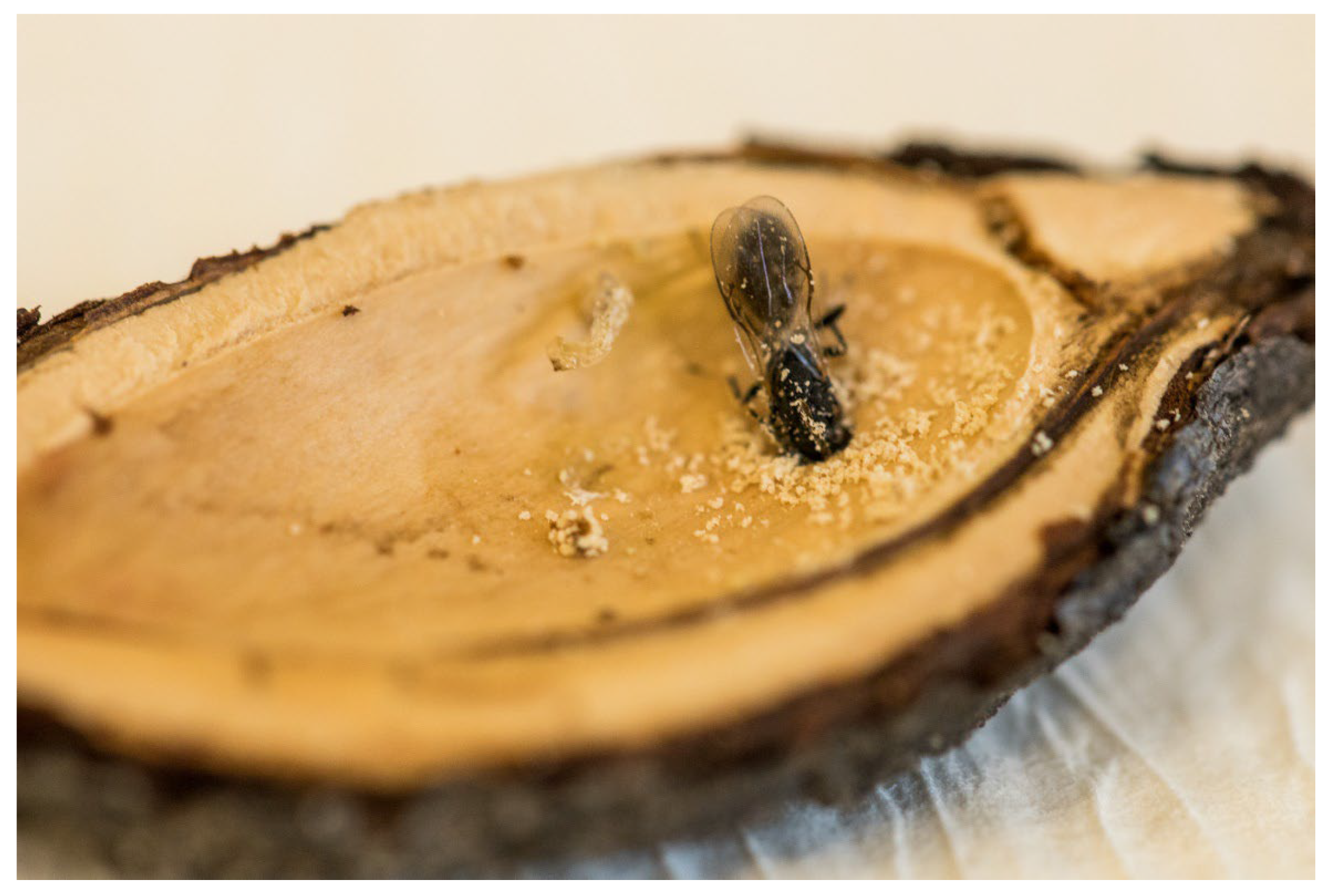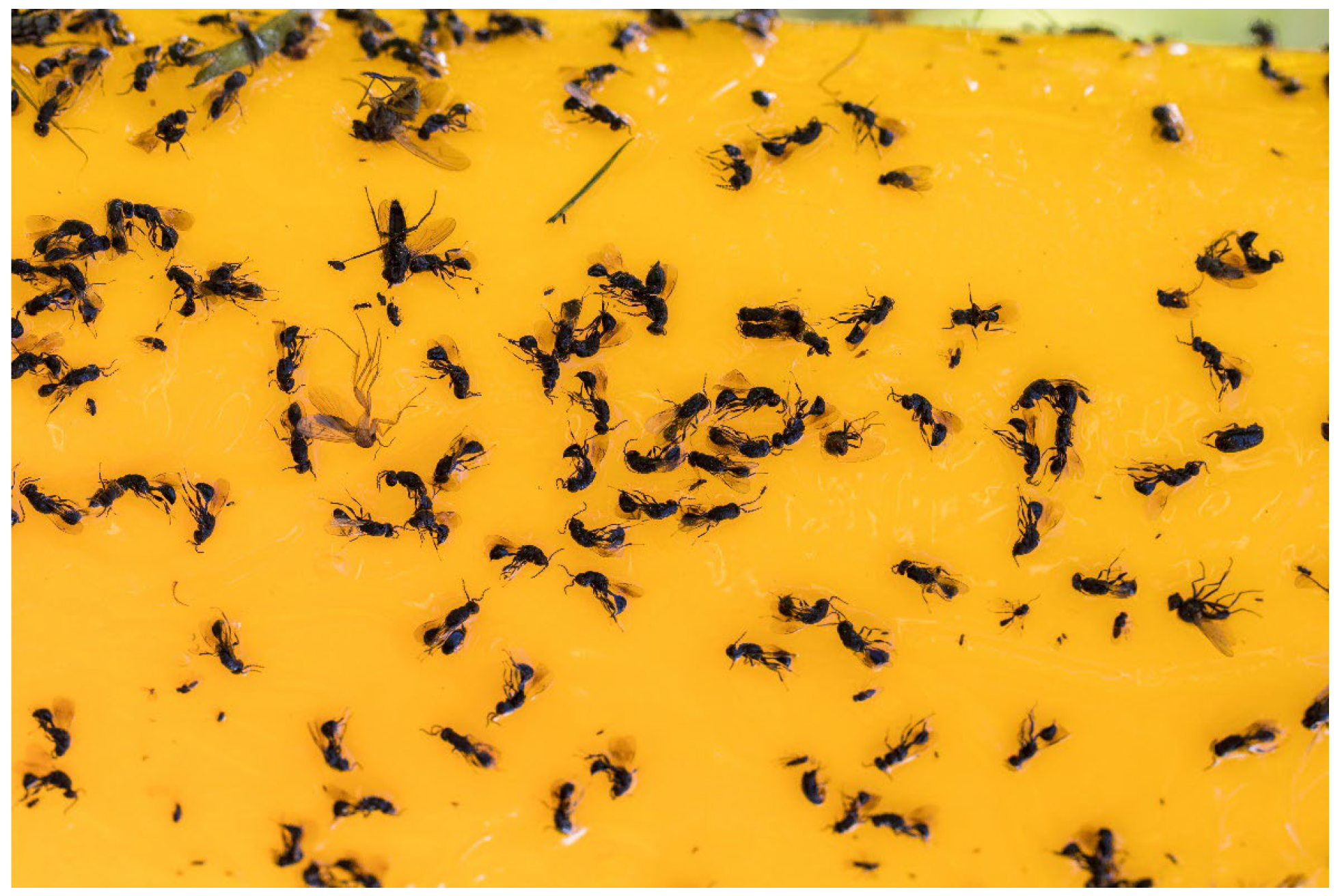A New Invasive Pest in Plums: Monitoring and Control of Eurytoma schreineri
Simple Summary
Abstract
1. Introduction
1.1. Host Plants
1.2. Insect Description
1.3. Life Cycle
1.4. Symptoms of Damage
1.5. Control
2. Materials and Methods
2.1. Attractiveness of Colour Sticky Traps
2.2. Residual Efficacy of Insecticides
2.3. Contact Efficacy of Insecticides
2.4. Field Trial
2.5. Statistical Analysis
3. Results
3.1. Attractiveness of Colour Sticky Traps
3.2. Residual Effect of the Tested Agrochemicals
3.3. Contact Effect of the Tested Agrochemicals
3.4. Efficacy of Applied Protection System
4. Discussion
4.1. Attractiveness of Colour Sticky Traps
4.2. Residual, Contact, and Field Efficacy Tests of Agrochemicals
5. Conclusions
Author Contributions
Funding
Data Availability Statement
Conflicts of Interest
References
- Tamas, R.; Oltean, I.; Florian, T. Studies on the Biology and the Ecology Pest Eurytoma schreineri (Waspy Plum Seed), in Mureş County. Bull. UASVM Hortic. 2008, 66, 229–232. [Google Scholar]
- Perju, T.; Peiu, M. A new pest of plum orchards in Romania-Eurytoma schreineri Schr. Prod. Veg. Hortic. 1980, 29, 18–21. [Google Scholar]
- Özbek, H.; Güçlü, S.; Hayat, R. Investigations on the Phytophagous and Predator Insect Species on Stone-Fruits in North-East Agricultural Region of Turkey. Turk. J. Agric. For. 1996, 20, 267–282. [Google Scholar] [CrossRef]
- Ayaz, T.; Bolu, H. A new pest apricotorchards in Malatya province, Eurytoma schreineri Schreiner (Hymenoptera: Eurytomidae). Türk. Entomol. Bült. 2012, 2, 271–275. [Google Scholar]
- Koveos, D.S.; Katsoyannos, B.I.; Broufas, G. First record of Eurytoma schreineri Schreiner (Hym., Eurytomidae) in Greece and some observations on its phenology. J. Appl. Entomol. 2002, 126, 186–187. [Google Scholar] [CrossRef]
- Růžička, T. Eurytoma schreineri is a New Stone Fruit Pest in the Czech Republic; Central Institute for Supervising and Testing in Agriculture: Brno, Czech Republic, 2014. [Google Scholar]
- Arnaudov, V.; Andreev, R.; Kutinkova, H.; Raikov, S. First Record of Eurytoma schreineri Schreiner (Hym., Eurytomidae) in Bulgaria. In Proceedings of the 52nd Croatian and 12th International Symposium on Agriculture 2017, Dubrovnik, Croatia, 12–17 February 2017; pp. 44–46. [Google Scholar]
- Bancă, G.; Mitrea, I. Research Regarding the Biology and Ecology of the Eurytoma schreineri Schr. at S.C.D.P. J. Sci. Work.-Hortic. Ser. 2012, 55, 585–588. [Google Scholar]
- Kloutvorová, J.; Skalský, M.; Lánský, M.; Ouředníčková, J.; Demelová, Š.; Jaklová, P. Metodika Ochrany Peckovin Proti Chorobám a Škůdcům; Certifikovaná Metodika; VŠÚO: Holovousy, Czech Republic, 2015. [Google Scholar]
- Arnaudov, V.; Davidova, R.; Vasiljev, V. Biology, ecology and control of the plum seed wasp [Eurytoma schreineri Schreiner (Hymenoptera: Eurytomidae)]. Agrofor Int. J. 2020, 5, 54–60. [Google Scholar] [CrossRef]
- Fursov, V.N.; Zerova, M.D. The Palaearctic species of Eurytoma (Hymenoptera: Eurytomidae) developing in stone fruits (Rosaceae: Prunoideae). Bull. Entomol. Res. 1991, 81, 209–219. [Google Scholar]
- Ouředníčková, J.; Skalský, M. Monitoring dospělců tmavky švestkové (Eurytoma schreineri) pomocí optických lapačů. Rostlinolékař 2020, 31, 18–20. [Google Scholar]
- Tertyshny, A.S. Plum eurytoma (Eurytoma schreineri Schr.) and its control in Eastern Ukraine. J. Fruit Ornam. Plant Res. 1997, 5, 35–41. [Google Scholar]
- Moldovan, C.; Zagrai, I.; Maxim, A.; Guzu, G. Evaluation of an Organic Treatment Scheme against Eurytoma schreineri Schreiner. Bull. UASVM Hortic. 2020, 77, 1843–5394. [Google Scholar] [CrossRef]
- Clark, T.G.; Bradburn, M.J.; Love, S.B.; Altman, D.G. Survival analysis part I: Basic concepts and first analyses. Br. J. Cancer 2003, 89, 232–238. [Google Scholar] [CrossRef] [PubMed]
- RStudio Team. RStudio: Integrated Development for R; RStudio Inc.: Boston, MA, USA, 2019. [Google Scholar]
- Hothorn, T.; Hornik, K. exactRankTests: Exact Distributions for Rank and Permutation Tests. Version 0.8-34. Available online: https://www.ubuntuupdates.org/package/core/jammy/universe/base/r-cran-exactranktests (accessed on 12 June 2023).
- Kassambara, A.; Kosinski, M.; Biecek, P.; Fabian, S. survminer: Drawing Survival Curves Using ‘ggplot2’. Version 0.4.9. Available online: https://cran.r-project.org/web/packages/survminer/index.html (accessed on 12 June 2023).
- Wright, M.N.; Ziegler, A. ranger: A Fast Implementation of Random Forests for High Dimensional Data in C++ and R. J. Stat. Softw. 2017, 77, 1–17. [Google Scholar] [CrossRef]
- Wickham, H. ggplot2: Elegant Graphics for Data Analysis; Springer: New York, NY, USA, 2016; ISBN 978-3-319-24277-4. [Google Scholar]
- Wickham, H.; François, R.; Henry, L.; Müller, K. dplyr: A Grammar of Data Manipulation. 2022, Version 1.0.8. Available online: https://dplyr.tidyverse.org/ (accessed on 12 June 2023).
- Horikoshi, M.; Tang, Y. ggfortify: Data Visualization Tools for Statistical Analysis Results. 2018. Available online: https://CRAN.R-project.org/package=ggfortify (accessed on 12 June 2023).
- Henry, L.; Wickham, H.; Collet, Y. rlang: Functions for Base Types and Core R and ‘Tidyverse’ Features, Version 1.0.2. 2022. Available online: https://github.com/r-lib/rlang (accessed on 12 June 2023).
- Rodica, S. Studies Regarding the Morphology, Bioecology and Integrated Control of the Eurytoma schreineri Schr. Species in Condition of Transilvania. Ph.D. Thesis, University of Agricultural Sciences and Veterinary Medicine Cluj Napoca Phd School, Cluj-Napoca, Romania, 2012. [Google Scholar]
- Tălmaciu, N.; Tălmaciu, M.; Georgescu, T.; Diaconu, A. The Efficiency of Some Insecticides Used for Controlling Grapholitha funebrana Tr. and Eurytoma schreineri Schr. Pests, in the Plum Tree Plantations. 2006. Available online: https://repository.iuls.ro/xmlui/handle/20.500.12811/2804 (accessed on 12 June 2023).










| Active Ingredient | Trade Name and Formulation | Dose ha−1 | Year of Testing | Registrant |
|---|---|---|---|---|
| Thiacloprid (480 g L−1) | Calypso 480 SC® | 0.25 L | 2023 | Bayer AG (Leverkusen, Germany) |
| Spinosad (240 g L−1) | SpinTor® | 0.4 L | 2023 2024 | Dow AgroSciences Ltd. (Indianapolis, IN, USA) |
| Spirotetramat (100 g L−1) | Movento 100 SC® | 1.5 L | 2023 | Bayer S.A.S. (Lyon, France) |
| 3D-IPNS polymers + silicons | Siltac EC® | 1.5 L | 2023 | ICB Pharma (Monheim, Germany) |
| Acetamiprid (200 g L−1) | Mospilan 20 SP® | 0.25 kg | 2024 | Nisso Chemical Europe GmbH (Düsseldorf, Germany) |
| Cyantraniliprole (100 g L−1) | Benevia® | 0.75 L | 2024 | FMC Agro (Prague, Czech Republic) |
| Spinetoram (120 g L−1) | Radiant SC® | 0.40 L | 2024 | Dow AgroSciences Ltd. (Indianapolis, IN, USA) |
| Sulfoxaflor (120 g L−1) | Gondola® | 0.20 L | 2024 | Dow AgroSciences Ltd. (Indianapolis, IN, USA) |
| Year | Type of Trap | Median | IQR |
|---|---|---|---|
| 2023 | Blue sticky desk | 0.0 b | 0.5 |
| Green sticky desk | 3.0 a | 4.5 | |
| Red sticky desk | 0.0 b | 2.0 | |
| White sticky desk | 2.0 a | 5.5 | |
| Yellow sticky desk | 8.0 aB | 24.5 | |
| Yellow Rebell cross trap | - | - | |
| Yellow bottle trap | - | - | |
| 2024 | Blue sticky desk | 0.0 c | 2.0 |
| Green sticky desk | 3.0 b | 20.0 | |
| Red sticky desk | 1.0 bc | 10.5 | |
| Yellow sticky desk | 64.0 aA | 87.5 | |
| White sticky desk | 0.0 bc | 2.5 | |
| Yellow Rebell cross trap | 46.0 a | 111.0 | |
| Yellow bottle trap | 18.0 a | 127.0 |
| Treatment | Replication | Infested Plums | Not Infested Plums |
|---|---|---|---|
| Treated orchard | A (n = 100) | 28 | 72 |
| B (n = 100) | 10 | 90 | |
| C (n = 100) | 7 | 93 | |
| D (n = 100) | 35 | 65 | |
| E (n = 100) | 31 | 69 | |
| Total (n = 500) | 111 | 389 | |
| Untreated orchard | A (n = 100) | 70 | 30 |
| B (n = 100) | 92 | 8 | |
| C (n = 100) | 83 | 17 | |
| D (n = 100) | 73 | 27 | |
| E (n = 100) | 78 | 22 | |
| Total (n = 500) | 396 | 104 |
Disclaimer/Publisher’s Note: The statements, opinions and data contained in all publications are solely those of the individual author(s) and contributor(s) and not of MDPI and/or the editor(s). MDPI and/or the editor(s) disclaim responsibility for any injury to people or property resulting from any ideas, methods, instructions or products referred to in the content. |
© 2025 by the authors. Licensee MDPI, Basel, Switzerland. This article is an open access article distributed under the terms and conditions of the Creative Commons Attribution (CC BY) license (https://creativecommons.org/licenses/by/4.0/).
Share and Cite
Ouředníčková, J.; Skalský, M.; Mészáros, M. A New Invasive Pest in Plums: Monitoring and Control of Eurytoma schreineri. Insects 2025, 16, 1112. https://doi.org/10.3390/insects16111112
Ouředníčková J, Skalský M, Mészáros M. A New Invasive Pest in Plums: Monitoring and Control of Eurytoma schreineri. Insects. 2025; 16(11):1112. https://doi.org/10.3390/insects16111112
Chicago/Turabian StyleOuředníčková, Jana, Michal Skalský, and Martin Mészáros. 2025. "A New Invasive Pest in Plums: Monitoring and Control of Eurytoma schreineri" Insects 16, no. 11: 1112. https://doi.org/10.3390/insects16111112
APA StyleOuředníčková, J., Skalský, M., & Mészáros, M. (2025). A New Invasive Pest in Plums: Monitoring and Control of Eurytoma schreineri. Insects, 16(11), 1112. https://doi.org/10.3390/insects16111112






